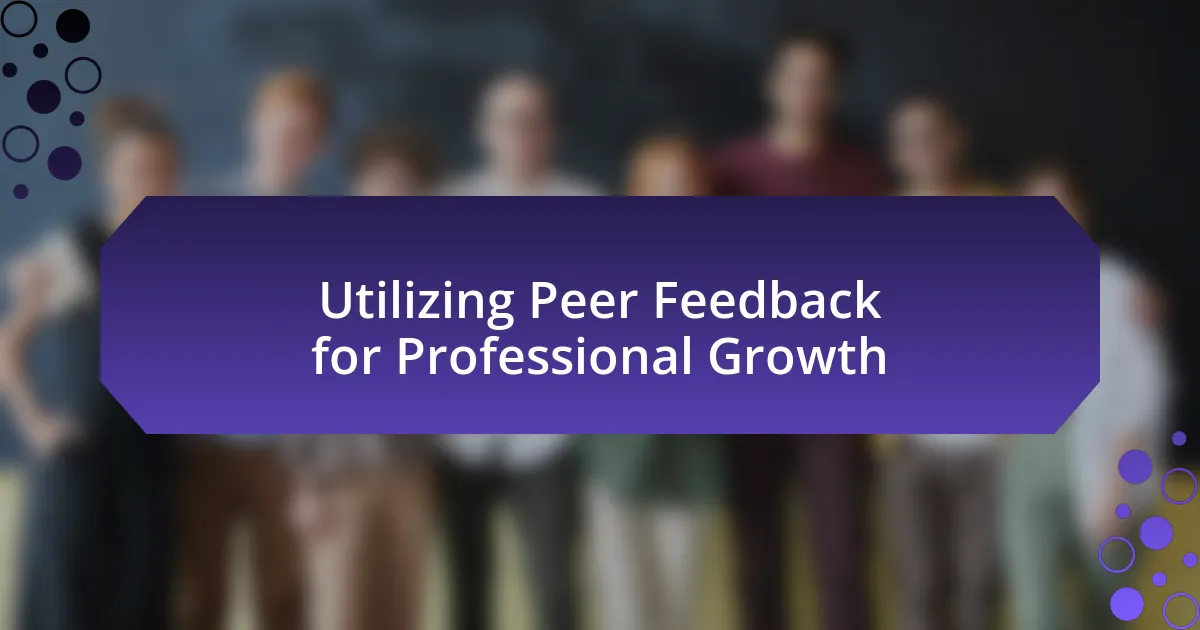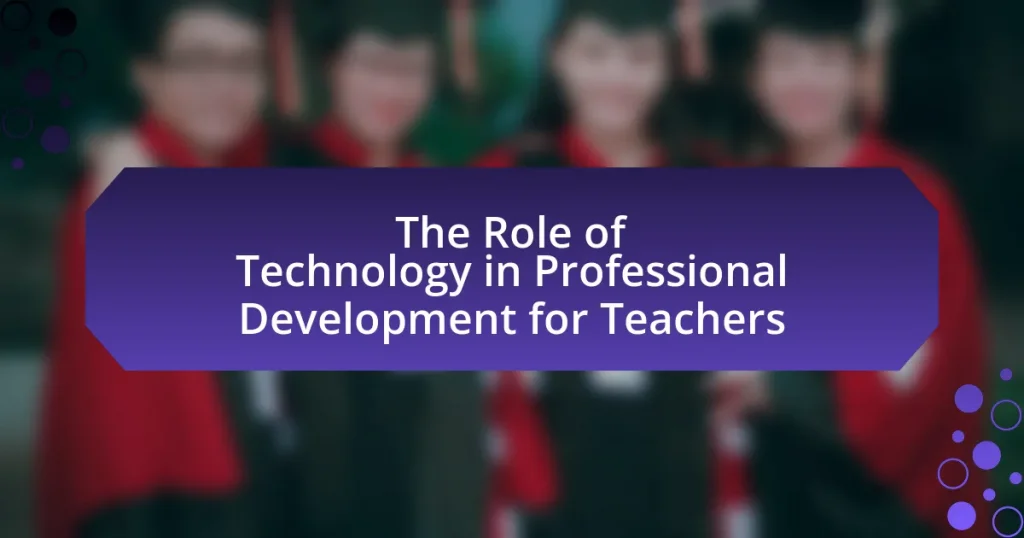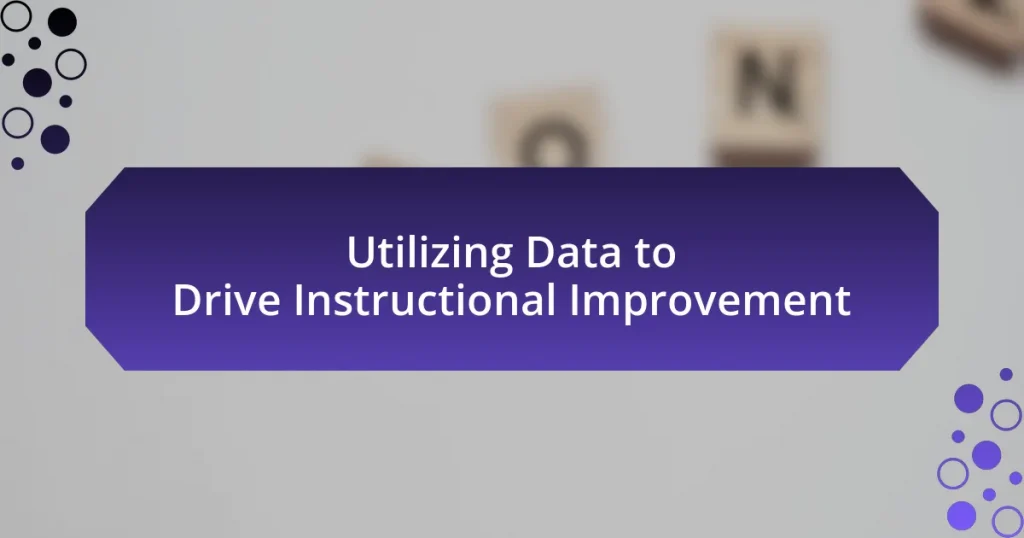Peer feedback is a collaborative process where colleagues provide constructive criticism and insights on each other’s work, significantly contributing to professional growth. This article explores the role of peer feedback in enhancing individual development, self-awareness, and team dynamics, while also addressing its impact on organizational culture. Key elements of effective peer feedback, such as specificity, constructiveness, and timeliness, are discussed alongside best practices for giving and receiving feedback. Additionally, the article examines common challenges associated with peer feedback and offers strategies for overcoming these obstacles to foster a culture of continuous improvement in the workplace.
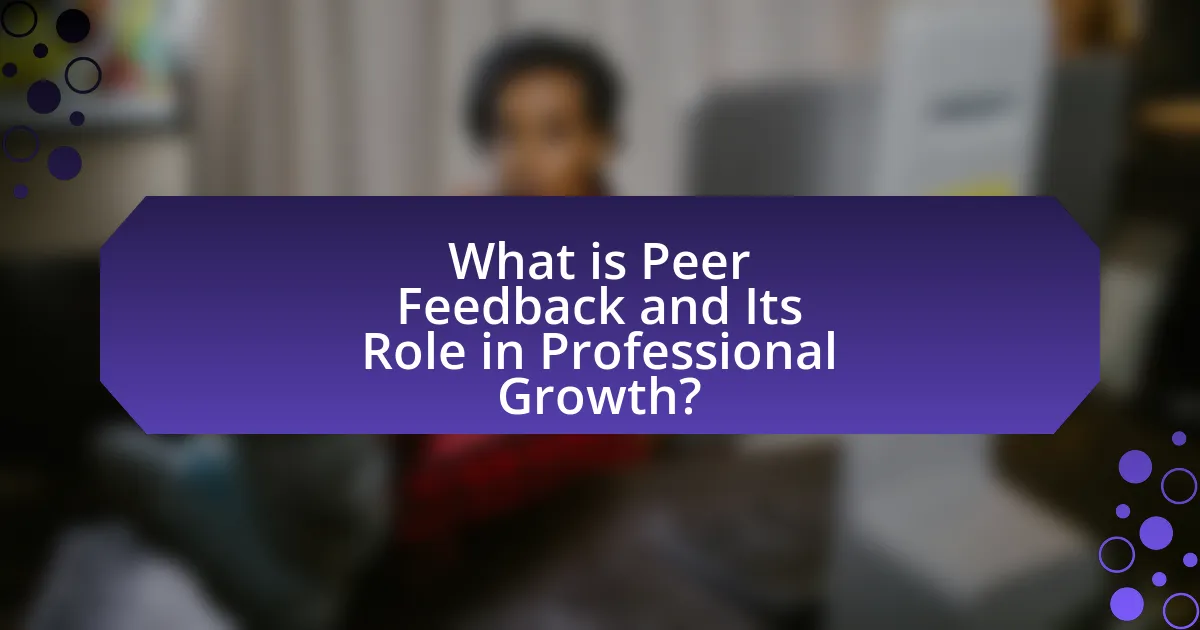
What is Peer Feedback and Its Role in Professional Growth?
Peer feedback is a process where colleagues provide constructive criticism and insights on each other’s work, fostering a collaborative environment for improvement. This practice plays a crucial role in professional growth by enhancing skills, increasing self-awareness, and promoting a culture of continuous learning. Research indicates that individuals who engage in peer feedback report higher levels of job satisfaction and performance, as it encourages open communication and accountability among team members. Furthermore, a study published in the Journal of Educational Psychology found that peer feedback significantly improves learning outcomes, demonstrating its effectiveness in professional development contexts.
How does peer feedback contribute to individual development?
Peer feedback significantly contributes to individual development by providing diverse perspectives that enhance self-awareness and skill improvement. When individuals receive constructive criticism from peers, they gain insights into their strengths and weaknesses, which fosters personal growth. Research indicates that peer feedback can lead to a 20% increase in performance outcomes, as it encourages reflection and motivates individuals to refine their skills. Additionally, a study published in the Journal of Educational Psychology found that students who engaged in peer feedback reported higher levels of engagement and satisfaction, further supporting the notion that collaborative evaluation is essential for individual development.
What are the key elements of effective peer feedback?
The key elements of effective peer feedback include specificity, constructiveness, and timeliness. Specificity ensures that feedback addresses particular aspects of the work, making it actionable; for example, instead of saying “good job,” a peer might say, “the introduction clearly outlines the main argument.” Constructiveness involves providing suggestions for improvement rather than just criticism, which fosters a supportive environment; for instance, suggesting alternative approaches or resources can enhance the recipient’s understanding. Timeliness refers to delivering feedback promptly, allowing the recipient to apply it while the work is still fresh, which is crucial for effective learning and growth. Research indicates that feedback delivered within a week of the task completion is most beneficial for improvement (Hattie & Timperley, 2007).
How can peer feedback enhance self-awareness in professionals?
Peer feedback enhances self-awareness in professionals by providing external perspectives on their behaviors and performance. This external input allows individuals to identify blind spots in their self-perception, leading to a more accurate understanding of their strengths and weaknesses. Research indicates that receiving constructive feedback can significantly improve self-reflection and personal development, as professionals are often unaware of how their actions impact others. For instance, a study published in the Journal of Applied Psychology found that individuals who actively sought peer feedback reported higher levels of self-awareness and job satisfaction. This process fosters a culture of openness and continuous improvement, ultimately contributing to professional growth.
Why is peer feedback important in the workplace?
Peer feedback is important in the workplace because it enhances individual and team performance through constructive insights. When colleagues provide feedback, it fosters a culture of open communication, leading to improved collaboration and innovation. Research indicates that organizations that implement peer feedback mechanisms experience a 14.9% increase in productivity, as employees feel more engaged and valued. Additionally, peer feedback helps identify blind spots in performance, allowing for targeted development and skill enhancement, which ultimately contributes to overall organizational success.
What impact does peer feedback have on team dynamics?
Peer feedback significantly enhances team dynamics by fostering open communication and collaboration among team members. When individuals provide constructive feedback to one another, it encourages a culture of trust and accountability, which is essential for effective teamwork. Research indicates that teams that engage in regular peer feedback demonstrate improved performance and higher levels of engagement, as members feel valued and heard. For instance, a study published in the Journal of Applied Psychology found that teams that utilized peer feedback mechanisms reported a 20% increase in overall productivity and a 30% improvement in team cohesion. This evidence underscores the positive impact of peer feedback on team dynamics, leading to more effective collaboration and enhanced professional growth.
How does peer feedback influence organizational culture?
Peer feedback significantly influences organizational culture by fostering open communication and collaboration among employees. This practice encourages a culture of continuous improvement, where individuals feel valued and empowered to share insights and suggestions. Research indicates that organizations that implement structured peer feedback mechanisms report higher employee engagement and satisfaction levels, as employees perceive their contributions as meaningful. For instance, a study by London and Smither (1999) found that peer feedback enhances performance and promotes a culture of accountability, leading to improved team dynamics and overall organizational effectiveness.
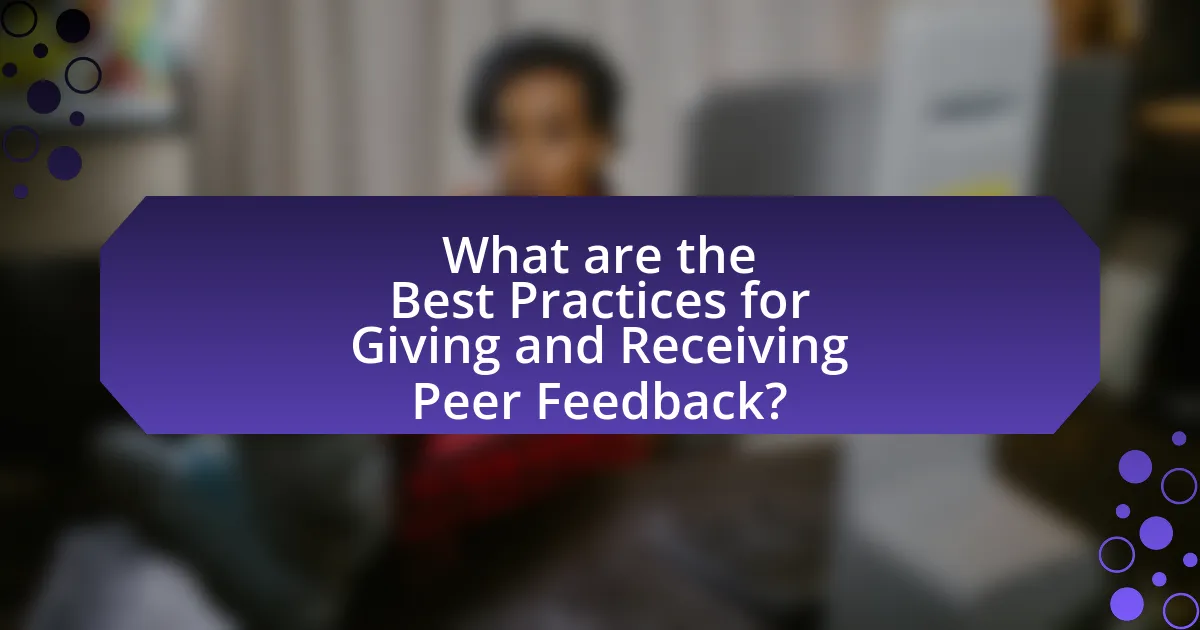
What are the Best Practices for Giving and Receiving Peer Feedback?
The best practices for giving and receiving peer feedback include being specific, constructive, and timely. When providing feedback, focus on observable behaviors and outcomes rather than personal attributes, which helps the recipient understand the context and make improvements. For instance, instead of saying “You did a bad job,” a more effective approach would be “The report lacked clarity in the analysis section, which made it hard to follow.” This specificity allows the recipient to identify areas for improvement.
Additionally, feedback should be balanced, highlighting both strengths and areas for growth. Research indicates that balanced feedback increases receptiveness and motivation to improve (Kluger & DeNisi, 1996). When receiving feedback, it is essential to listen actively, ask clarifying questions, and reflect on the input without becoming defensive. This approach fosters a growth mindset and encourages continuous learning. Engaging in a dialogue about the feedback can also enhance understanding and application.
How can professionals effectively give constructive feedback?
Professionals can effectively give constructive feedback by being specific, focusing on behavior rather than personal attributes, and providing actionable suggestions for improvement. Specific feedback helps the recipient understand exactly what actions or behaviors need to change, while focusing on behavior ensures that the feedback is objective and not perceived as a personal attack. For instance, instead of saying “You are not a good team player,” a more constructive approach would be, “During the last project meeting, you interrupted others frequently, which made collaboration difficult. In future meetings, try to listen more before responding.” This method not only highlights the issue but also offers a clear path for improvement, making it easier for the recipient to act on the feedback.
What techniques can be used to ensure feedback is well-received?
To ensure feedback is well-received, techniques such as using a positive tone, being specific, and encouraging a two-way dialogue are effective. A positive tone helps create a supportive environment, making the recipient more open to receiving feedback. Specificity in feedback allows the recipient to understand exactly what behaviors or actions need to be addressed, which enhances clarity and reduces ambiguity. Encouraging a two-way dialogue fosters engagement, allowing the recipient to ask questions and express their thoughts, which can lead to a more constructive conversation. Research indicates that feedback delivered in a constructive manner, focusing on behaviors rather than personal attributes, significantly increases the likelihood of acceptance and implementation (Stone & Heen, 2014, “Thanks for the Feedback: The Science and Art of Receiving Feedback Well”).
How can feedback be tailored to different personality types?
Feedback can be tailored to different personality types by understanding their unique traits and preferences. For example, analytical individuals may prefer data-driven feedback that includes specific metrics and detailed analysis, while expressive personalities might respond better to feedback that is delivered in a more enthusiastic and supportive manner. Research indicates that adapting feedback styles to align with personality traits can enhance receptiveness and effectiveness, as demonstrated in a study by Grant and Parker (2009) published in the Journal of Applied Psychology, which found that personalized feedback significantly improved performance outcomes.
What strategies can enhance the feedback process?
To enhance the feedback process, implementing structured peer review sessions is essential. Structured sessions provide a clear framework for giving and receiving feedback, ensuring that all participants understand the objectives and criteria for evaluation. Research indicates that when feedback is specific, timely, and actionable, it significantly improves learning outcomes and professional development. For instance, a study published in the Journal of Educational Psychology found that students who engaged in peer feedback reported higher levels of satisfaction and perceived learning compared to those who did not participate in such activities. Additionally, fostering a culture of openness and trust among peers encourages honest and constructive feedback, further enhancing the effectiveness of the process.
How can regular feedback sessions be structured for maximum benefit?
Regular feedback sessions can be structured for maximum benefit by implementing a clear agenda, setting specific goals, and ensuring a safe environment for open communication. Establishing a structured agenda allows participants to prepare and focus on key topics, while setting specific goals ensures that feedback is actionable and relevant. Creating a safe environment encourages honest dialogue, which is essential for constructive criticism. Research indicates that organizations that prioritize structured feedback sessions see a 14.9% increase in employee performance, highlighting the effectiveness of this approach.
What tools can facilitate effective peer feedback exchanges?
Tools that can facilitate effective peer feedback exchanges include online platforms such as Google Docs, Slack, and Microsoft Teams. Google Docs allows real-time collaboration and commenting, enabling peers to provide immediate feedback on shared documents. Slack offers channels for discussion and file sharing, making it easy for team members to engage in ongoing feedback conversations. Microsoft Teams integrates chat, video calls, and file sharing, fostering a collaborative environment for feedback. These tools enhance communication and streamline the feedback process, ultimately supporting professional growth through constructive peer interactions.
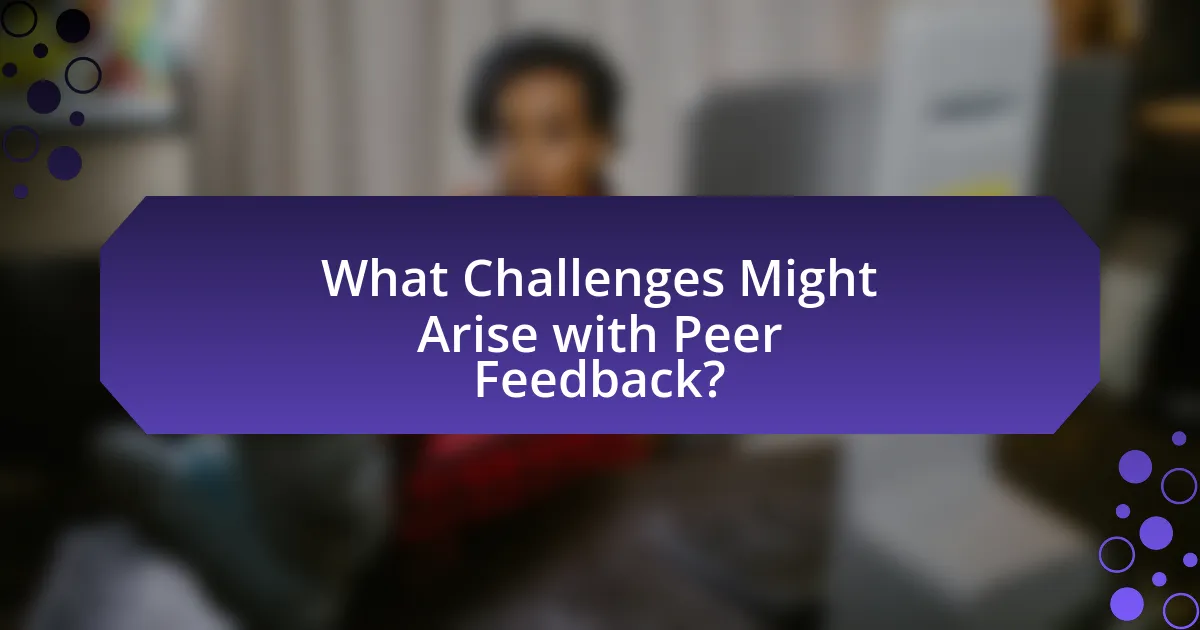
What Challenges Might Arise with Peer Feedback?
Challenges that might arise with peer feedback include bias, lack of expertise, and potential interpersonal conflicts. Bias can occur when peers provide feedback based on personal relationships rather than objective criteria, leading to skewed evaluations. A lack of expertise may result in peers offering feedback that is not informed or constructive, which can hinder professional growth. Additionally, interpersonal conflicts can arise if feedback is perceived as personal criticism, potentially damaging team dynamics and collaboration. These challenges can undermine the effectiveness of peer feedback in fostering professional development.
What common obstacles do professionals face when giving feedback?
Professionals commonly face obstacles such as fear of conflict, lack of clarity, and emotional discomfort when giving feedback. Fear of conflict can prevent individuals from delivering honest feedback, as they worry about damaging relationships or creating tension. Lack of clarity often arises when professionals are unsure about how to articulate their thoughts effectively, leading to vague or unhelpful feedback. Emotional discomfort, stemming from anxiety about how the recipient will react, can also hinder the feedback process. Research indicates that these barriers can significantly impact the effectiveness of feedback, as highlighted in studies on workplace communication dynamics.
How can fear of conflict hinder the feedback process?
Fear of conflict can significantly hinder the feedback process by preventing open and honest communication. When individuals are afraid of potential disagreements or negative reactions, they may withhold constructive criticism or fail to express their true opinions. This avoidance leads to superficial feedback, which lacks depth and fails to address underlying issues. Research indicates that environments where conflict is avoided often result in decreased team performance and innovation, as team members do not feel safe to share diverse perspectives or challenge the status quo. Consequently, the overall effectiveness of peer feedback diminishes, limiting opportunities for professional growth and development.
What are the potential biases that can affect feedback quality?
Potential biases that can affect feedback quality include confirmation bias, halo effect, and recency effect. Confirmation bias occurs when individuals favor information that confirms their pre-existing beliefs, leading to skewed feedback. The halo effect influences feedback when a positive or negative impression of a person affects the overall evaluation of their performance, regardless of specific behaviors. The recency effect causes individuals to weigh recent events more heavily than earlier ones, which can distort the assessment of overall performance. These biases can significantly compromise the objectivity and effectiveness of peer feedback in professional growth contexts.
How can organizations overcome challenges related to peer feedback?
Organizations can overcome challenges related to peer feedback by establishing a structured feedback process that encourages open communication and trust among team members. Implementing regular feedback sessions, utilizing anonymous surveys, and providing training on giving and receiving feedback can create a safe environment for sharing insights. Research shows that organizations with structured feedback mechanisms report a 25% increase in employee engagement and satisfaction, as employees feel more valued and understood. By fostering a culture that prioritizes constructive feedback, organizations can enhance collaboration and drive professional growth.
What training can be provided to improve feedback skills?
Training to improve feedback skills can include workshops focused on effective communication techniques, role-playing exercises to practice giving and receiving feedback, and structured peer review sessions. These training methods enhance participants’ ability to articulate constructive criticism and foster a culture of open dialogue. Research indicates that organizations implementing feedback training see a 20% increase in employee engagement and performance, as highlighted in a study by the Harvard Business Review, which emphasizes the importance of feedback in professional development.
How can a supportive environment be cultivated for open feedback?
A supportive environment for open feedback can be cultivated by establishing clear communication norms and fostering trust among team members. Clear communication norms ensure that everyone understands the expectations for giving and receiving feedback, which can include guidelines on constructive criticism and active listening. Fostering trust involves creating a culture where individuals feel safe to express their thoughts without fear of retaliation or judgment. Research indicates that organizations with high levels of trust report 50% higher employee engagement and productivity, demonstrating the importance of trust in facilitating open dialogue. Additionally, regular feedback sessions and training on effective feedback techniques can further enhance this supportive environment, encouraging continuous improvement and professional growth.
What are the Practical Tips for Implementing Peer Feedback Effectively?
Practical tips for implementing peer feedback effectively include establishing clear guidelines, fostering a supportive environment, and encouraging specific, actionable comments. Clear guidelines help participants understand the feedback process, ensuring that feedback is constructive and focused on improvement. A supportive environment promotes open communication, making peers feel comfortable sharing their insights. Encouraging specific comments, rather than vague statements, allows for targeted improvements and enhances the overall effectiveness of the feedback. Research indicates that structured peer feedback can lead to significant improvements in performance and learning outcomes, as highlighted in studies by Topping (1998) and Nicol & Macfarlane-Dick (2006), which emphasize the importance of clarity and specificity in feedback for professional growth.
How can professionals create a culture of continuous feedback?
Professionals can create a culture of continuous feedback by implementing regular check-ins and establishing clear communication channels. Regular check-ins, such as weekly or bi-weekly meetings, allow team members to share insights and provide constructive feedback on ongoing projects. Establishing clear communication channels, such as dedicated platforms for feedback, encourages open dialogue and ensures that feedback is timely and relevant. Research shows that organizations with a strong feedback culture experience 14.9% lower turnover rates, highlighting the importance of continuous feedback in employee retention and engagement.
What are the best practices for following up on feedback received?
The best practices for following up on feedback received include acknowledging the feedback, seeking clarification if needed, and implementing actionable changes based on the insights provided. Acknowledging feedback demonstrates respect and appreciation for the input, which fosters a positive dialogue. Seeking clarification ensures a clear understanding of the feedback, allowing for more effective application. Implementing actionable changes shows a commitment to growth and improvement, which can enhance professional development. Research indicates that individuals who actively engage with feedback are more likely to experience significant performance improvements, as highlighted in studies on feedback utilization in workplace settings.
